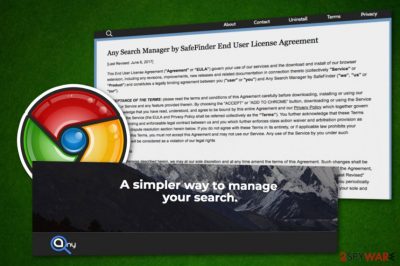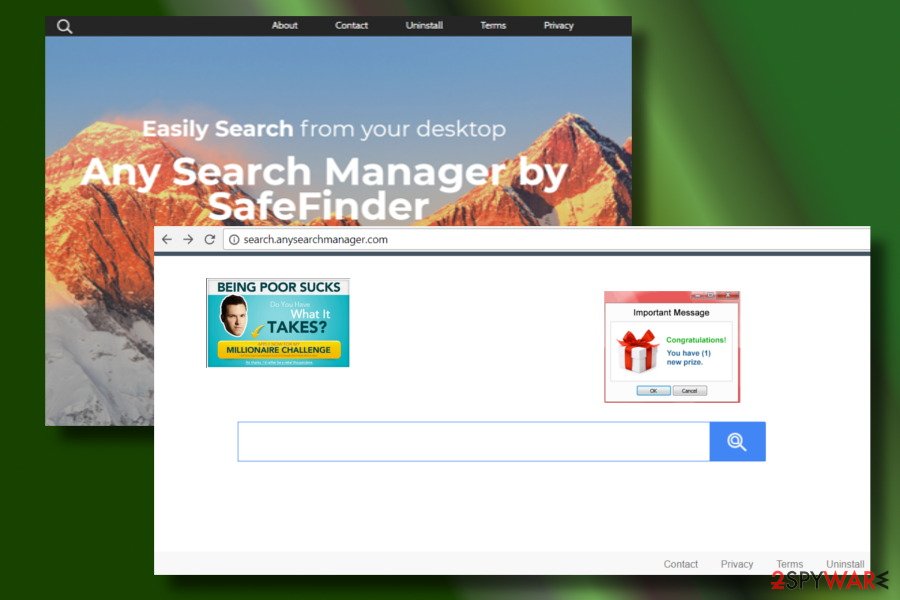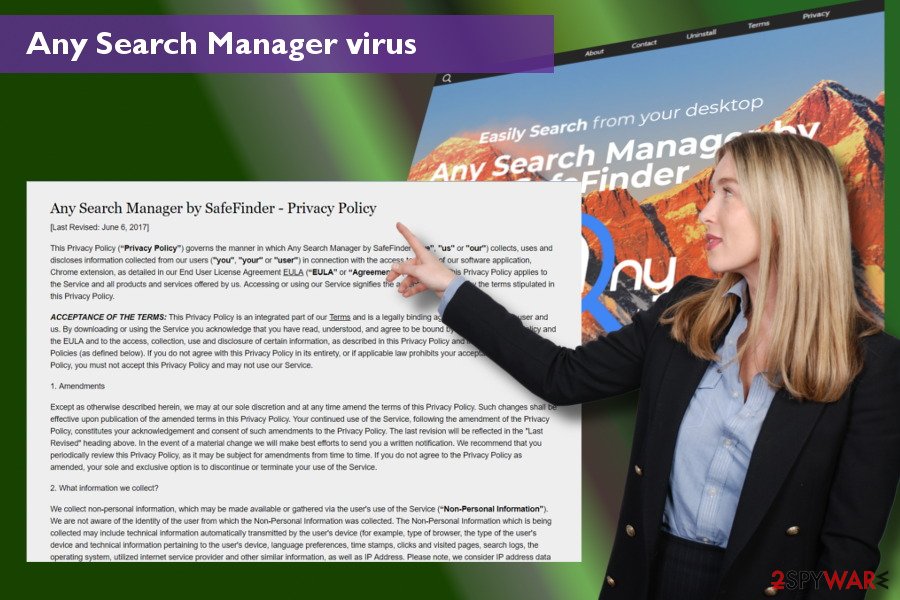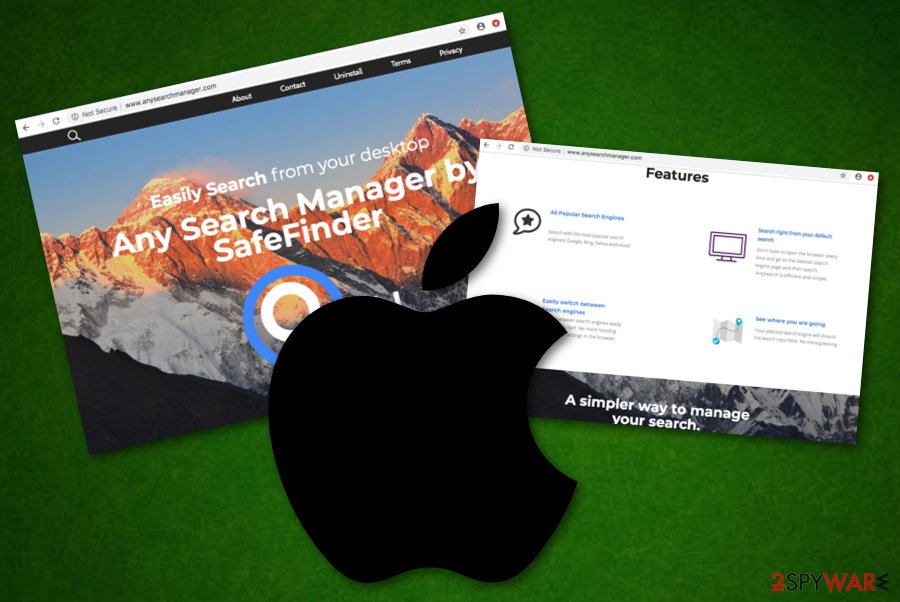Any Search Manager (Removal Guide) - Feb 2020 update
Any Search Manager Removal Guide
What is Any Search Manager?
Any Search Manager is a misleading extension which can hijack your computer after updating Flash Player

Any Search Manager is a suspicious web browser extension from Safe Finder virus family. Users claims state that this suspicious component appeared on Chrome, Firefox, and Safari after updating Flash Player. Nevertheless, an additional component named akamaihd.net which is a third-party advertising website has shown up together with the extension.[1] After Any Search Manager virus Mac appears on the machine, the user is forced to use Search.anysearch.com or Anysearchmanager.com as a default start page, search provider, and new tab URL. Security experts agree upon the fact that these types of features are typical to cyber infection groups called “browser hijacker” and “Potentially Unwanted Program” (PUP).[2]
| Name | Any Search Manager |
|---|---|
| Type | Browser hijacker |
| Related to | Search.anysearch.com; Anysearchmanager.com |
| Additional content | A user has stated that the extension came together with akamaihd.net |
| OS affected | Mostly, Mac OS X but can appear on Windows also |
| Promises | Claims to provide a simpler way to manage search sessions |
| Main issues caused | Redirects to third party websites, aggressive pop-up ads, slowdowns of web browsers |
| Main dangers | You can be redirected to a malicious website, reveal your private information or tricked into installing malware |
| Appearance | You can find the extension on its official website or it can be delivered to you through software bundles |
| Removal | To uninstall Any Search Manager, scan the system with FortectIntego. It is the easiest way to detect its files and other components |
Many threads are created on IT-related discussion forums where Google Chrome, Mozilla Firefox, and Safari users ask how to remove Any Search Manager from mac. Such questions are not surprising since AnySearch Manager removal can be a difficult task to perform. To eliminate this PUP, web browser users have to delete PUPs from the system and then reset all altered web browsers.
Users also often refer to this hijacker as Any Search Manager virus or Safe Finder virus. Although one might think that the latter association is related to the name of the developer, the truth is that this PUP usually spreads along with Safe Finder extension, which is yet another PUP initiating misleading advertising campaigns.
Any Search Manager does not harm the system directly. It might initiate a slight CPU[3] usage increment and web browsers slowdowns, but that's all it does directly. The rest of the tasks that it might be set to perform are initiated within the web browser. However, note that any changes that are made to your browser apps can be reversed only after Any Search Manager removal.
The reason why Any Search Manager replaces a default start page and search provider is clear – it seeks to promote affiliated websites. However, it's not clear what content its partners are hiding behind the links, so each time you click on the links provided by this dubious search engine, you risk exposing your PC at risk of malware or virus infection.[4]

Senzavirus.it[5] researchers recommend getting rid of this hijacker to prevent the web browser from generating intrusive pop-up and other forms of ads. Any Search Manager virus might be involved in shady advertising campaigns. Thus, be careful with ads promoting software updates, online virus scanners or asking to participate in online surveys.
Even though you are not fond of using a dubious site for your search activities, you may not be allowed to use alternative search. For that, you will have to put Any Search Manager Mac remove process as your top priority. Note that This extension may root deeply into the web browser, as well as alter Windows Registry entries, browser's shortcuts, Windows startup, and other settings that might be difficult to restore manually.
If you want to give manual PUP removal a try, you can use a step-by-step removal tutorial provided at the end of this article. If the procedure failed, try FortectIntego, SpyHunter 5Combo Cleaner or another security tool to uninstall Any Search Manager from Mac or Windows. After that, don't forget to reset your web browser to the previous state.

Another important reason to get rid of Any Search Manager from your affected computer system and clean all infected and hijacked web browsers is that this browser hijacker can collect information not only related to your browsing activities but also some more personal data such as your email address, and even IP address. This is also stated in the Privacy Policy of this extension's official page:
The second type of information is individually identifiable information, namely information that identifies an individual or entity or may with reasonable effort identify an individual (“Personal Information”). The Personal Information we collect on or through the Services includes the following:
- Contact Information: if you voluntarily contact us, you might provide us with your contact information such as your name and e-mail address, etc. we will use this information in order to respond to your request and support your needs as well as to send you updates and other commercial messages.
- “Identifiers”: we may collect certain identifiers such as your IP addresses.
Freeware packages are still in use for PUP distribution
The PUP we have just described have an official download source. The search engine it promotes can also be visited by directly typing its URL in the address bar. However, that's not enough as a ground that this search is reliable. In fact, the sign that it's alternatively distributed via freeware is the clearest sign that the tool cannot be trusted.
The question is how then PUPs like this manage to slither onto the system. For the sake of monetization, they are distributed via software packages alongside free apps. Therefore, it's essential to verify the installation of free programs to reject the installation of “optional downloads.”
Even the most accurate users will not see additional installers as long as they rely on Quick or Basic installation options. You can avoid PUPs by selecting Advanced or Custom installation and deselecting each “optional download” despite the fact that it's said to be free and useful.
If you have been suffering from unexpected redirects for a while, you should check your Mac or Windows OS for this hijacker. Browser hijackers and similar PUPs can show up on your computer when you don't expect that. Thus, it is useful to have at least a few Secure-surf.net removal options prepared in advance.

Delete Any Search Manager PUP from Mac and Windows
If you wonder how to stop unexpected web browser's redirects to suspicious domains or terminate intrusive advertisements, you must see a step-by-step removal tutorial created by our research team. It will help you to eliminate the virus manually. However, you must be very careful while performing every step which is needed to remove Any Search Manager from the system. Make sure you perform them in exact order.
If, however, you prefer spending time on more significant tasks than fixing your PC, automatic Any Search Manager removal is what you need. All you need for this method is to install a professional anti-malware tool and set it to run a deep scan. After all, reset web browser's default settings. Nevertheless, you can keep the anti-malware as security software after the process also.
Use video-based removal guidelines for an accurate view on Any Search Manager removal
If Any Search Manager virus has appeared out of nowhere and started to bother you, it is about time to opt for its elimination. In case you are a less-experienced user and have never completed manual termination before, we have created and provided a video clip that will guide you throughout the entire process. You can find it here:
You may remove virus damage with a help of FortectIntego. SpyHunter 5Combo Cleaner and Malwarebytes are recommended to detect potentially unwanted programs and viruses with all their files and registry entries that are related to them.
Getting rid of Any Search Manager. Follow these steps
Uninstall from Windows
Any Search Manager is not a virus. Nevertheless, it might be difficult to remove because it initiates multiple system's changes. However, this tutorial might help:
Instructions for Windows 10/8 machines:
- Enter Control Panel into Windows search box and hit Enter or click on the search result.
- Under Programs, select Uninstall a program.

- From the list, find the entry of the suspicious program.
- Right-click on the application and select Uninstall.
- If User Account Control shows up, click Yes.
- Wait till uninstallation process is complete and click OK.

If you are Windows 7/XP user, proceed with the following instructions:
- Click on Windows Start > Control Panel located on the right pane (if you are Windows XP user, click on Add/Remove Programs).
- In Control Panel, select Programs > Uninstall a program.

- Pick the unwanted application by clicking on it once.
- At the top, click Uninstall/Change.
- In the confirmation prompt, pick Yes.
- Click OK once the removal process is finished.
Delete from macOS
If the suspicious application has occurred on your Mac machine without your notice, you need to use these guidelines and clean Mac OS X fully:
Remove items from Applications folder:
- From the menu bar, select Go > Applications.
- In the Applications folder, look for all related entries.
- Click on the app and drag it to Trash (or right-click and pick Move to Trash)

To fully remove an unwanted app, you need to access Application Support, LaunchAgents, and LaunchDaemons folders and delete relevant files:
- Select Go > Go to Folder.
- Enter /Library/Application Support and click Go or press Enter.
- In the Application Support folder, look for any dubious entries and then delete them.
- Now enter /Library/LaunchAgents and /Library/LaunchDaemons folders the same way and terminate all the related .plist files.

Remove from Microsoft Edge
Delete unwanted extensions from MS Edge:
- Select Menu (three horizontal dots at the top-right of the browser window) and pick Extensions.
- From the list, pick the extension and click on the Gear icon.
- Click on Uninstall at the bottom.

Clear cookies and other browser data:
- Click on the Menu (three horizontal dots at the top-right of the browser window) and select Privacy & security.
- Under Clear browsing data, pick Choose what to clear.
- Select everything (apart from passwords, although you might want to include Media licenses as well, if applicable) and click on Clear.

Restore new tab and homepage settings:
- Click the menu icon and choose Settings.
- Then find On startup section.
- Click Disable if you found any suspicious domain.
Reset MS Edge if the above steps did not work:
- Press on Ctrl + Shift + Esc to open Task Manager.
- Click on More details arrow at the bottom of the window.
- Select Details tab.
- Now scroll down and locate every entry with Microsoft Edge name in it. Right-click on each of them and select End Task to stop MS Edge from running.

If this solution failed to help you, you need to use an advanced Edge reset method. Note that you need to backup your data before proceeding.
- Find the following folder on your computer: C:\\Users\\%username%\\AppData\\Local\\Packages\\Microsoft.MicrosoftEdge_8wekyb3d8bbwe.
- Press Ctrl + A on your keyboard to select all folders.
- Right-click on them and pick Delete

- Now right-click on the Start button and pick Windows PowerShell (Admin).
- When the new window opens, copy and paste the following command, and then press Enter:
Get-AppXPackage -AllUsers -Name Microsoft.MicrosoftEdge | Foreach {Add-AppxPackage -DisableDevelopmentMode -Register “$($_.InstallLocation)\\AppXManifest.xml” -Verbose

Instructions for Chromium-based Edge
Delete extensions from MS Edge (Chromium):
- Open Edge and click select Settings > Extensions.
- Delete unwanted extensions by clicking Remove.

Clear cache and site data:
- Click on Menu and go to Settings.
- Select Privacy, search and services.
- Under Clear browsing data, pick Choose what to clear.
- Under Time range, pick All time.
- Select Clear now.

Reset Chromium-based MS Edge:
- Click on Menu and select Settings.
- On the left side, pick Reset settings.
- Select Restore settings to their default values.
- Confirm with Reset.

Remove from Mozilla Firefox (FF)
If you have found any dubious helper objects in Firefox, terminate them with the help of these lines:
Remove dangerous extensions:
- Open Mozilla Firefox browser and click on the Menu (three horizontal lines at the top-right of the window).
- Select Add-ons.
- In here, select unwanted plugin and click Remove.

Reset the homepage:
- Click three horizontal lines at the top right corner to open the menu.
- Choose Options.
- Under Home options, enter your preferred site that will open every time you newly open the Mozilla Firefox.
Clear cookies and site data:
- Click Menu and pick Settings.
- Go to Privacy & Security section.
- Scroll down to locate Cookies and Site Data.
- Click on Clear Data…
- Select Cookies and Site Data, as well as Cached Web Content and press Clear.

Reset Mozilla Firefox
If clearing the browser as explained above did not help, reset Mozilla Firefox:
- Open Mozilla Firefox browser and click the Menu.
- Go to Help and then choose Troubleshooting Information.

- Under Give Firefox a tune up section, click on Refresh Firefox…
- Once the pop-up shows up, confirm the action by pressing on Refresh Firefox.

Remove from Google Chrome
The bulk of users asked how to remove this hijacker from Google Chrome. It's not clear whether it targets for Chrome users or that's just a coincidence. If, however, you are one of the victims, don't forget to reset Chrome right after the PUP removal:
Delete malicious extensions from Google Chrome:
- Open Google Chrome, click on the Menu (three vertical dots at the top-right corner) and select More tools > Extensions.
- In the newly opened window, you will see all the installed extensions. Uninstall all the suspicious plugins that might be related to the unwanted program by clicking Remove.

Clear cache and web data from Chrome:
- Click on Menu and pick Settings.
- Under Privacy and security, select Clear browsing data.
- Select Browsing history, Cookies and other site data, as well as Cached images and files.
- Click Clear data.

Change your homepage:
- Click menu and choose Settings.
- Look for a suspicious site in the On startup section.
- Click on Open a specific or set of pages and click on three dots to find the Remove option.
Reset Google Chrome:
If the previous methods did not help you, reset Google Chrome to eliminate all the unwanted components:
- Click on Menu and select Settings.
- In the Settings, scroll down and click Advanced.
- Scroll down and locate Reset and clean up section.
- Now click Restore settings to their original defaults.
- Confirm with Reset settings.

Delete from Safari
Remove unwanted extensions from Safari:
- Click Safari > Preferences…
- In the new window, pick Extensions.
- Select the unwanted extension and select Uninstall.

Clear cookies and other website data from Safari:
- Click Safari > Clear History…
- From the drop-down menu under Clear, pick all history.
- Confirm with Clear History.

Reset Safari if the above-mentioned steps did not help you:
- Click Safari > Preferences…
- Go to Advanced tab.
- Tick the Show Develop menu in menu bar.
- From the menu bar, click Develop, and then select Empty Caches.

After uninstalling this potentially unwanted program (PUP) and fixing each of your web browsers, we recommend you to scan your PC system with a reputable anti-spyware. This will help you to get rid of Any Search Manager registry traces and will also identify related parasites or possible malware infections on your computer. For that you can use our top-rated malware remover: FortectIntego, SpyHunter 5Combo Cleaner or Malwarebytes.
How to prevent from getting browser hijacker
Stream videos without limitations, no matter where you are
There are multiple parties that could find out almost anything about you by checking your online activity. While this is highly unlikely, advertisers and tech companies are constantly tracking you online. The first step to privacy should be a secure browser that focuses on tracker reduction to a minimum.
Even if you employ a secure browser, you will not be able to access websites that are restricted due to local government laws or other reasons. In other words, you may not be able to stream Disney+ or US-based Netflix in some countries. To bypass these restrictions, you can employ a powerful Private Internet Access VPN, which provides dedicated servers for torrenting and streaming, not slowing you down in the process.
Data backups are important – recover your lost files
Ransomware is one of the biggest threats to personal data. Once it is executed on a machine, it launches a sophisticated encryption algorithm that locks all your files, although it does not destroy them. The most common misconception is that anti-malware software can return files to their previous states. This is not true, however, and data remains locked after the malicious payload is deleted.
While regular data backups are the only secure method to recover your files after a ransomware attack, tools such as Data Recovery Pro can also be effective and restore at least some of your lost data.
- ^ alyssabeach. Remove "Any Search Manager" from Mac. Discussions. Apple forums.
- ^ Kevin Townsend. The Battle With "Potentially Unwanted" Programs in the Enterprise. Security Week. Internet and Enterprise Security Week.
- ^ Jon Martindale. What is a CPU?. Digital Trends. Computing.
- ^ Hackers spread malware via children's gaming websites. BBC News.
- ^ Senzavirus. Senzavirus. Virus and Spyware news.























